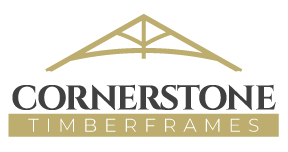For 34 years, Cornerstone has been producing high-quality timber frames for our customers. In this time, we’ve learned a lot about timber maintenance and applied that know-how to how we design and build. One particularly important area of knowledge is how to diminish and eliminate moisture damage.
Pergolas are a great example of the challenge we face, because by their very design, they are intended to be exposed to every kind of weather. How do you maximize the service life of a pergola? Here is our best advice in five steps:

Start with a water-resistant design. It’s in planning that most problems are avoided and costs are saved. Outdoor wood that is going to get wet should be designed with angled pieces, bevels and details that shed water. The design should also allow for rapid drying, especially for the critical post-to-beam and post-to-base connections. Joinery should limit water intake and have ways for water to escape.
Choose your wood. As cedar trees grow, they produce a host of natural preservatives that resist decay and deter insects, making cedar our top choice for exposed outdoor structures. Douglas fir trees also produce defensive compounds, but their preservatives are less effective. Fir can be used outside, but it needs capping or other protection to last. Pine and spruce should simply not be used outside unless the timber is under a roof.
Use excellent finishes. Our finishing shop staff are experts in the application of durable stains and treatments. We use a three-coat system of top-quality finish that gives outdoor wood fiber the best possible start. A coloured base coat soaks into the wood, and two clear topcoats add protection while offering a smooth satin finish that is easy to clean and maintain. To learn more about our process and finishing options, check out our blog, here.
Details that protect. Wood posts that sit directly on concrete are prone to rot, making stand-offs, essential protection. In 2014 Cornerstone developed its own custom solution, a stand-off base that looks great, brings smiles to engineers and keeps post bottoms dry. For timbers that are especially vulnerable to moisture, a variety of capping materials can make all the difference. Traditionally, cedar boards placed on top of beams or rafters were a type of “sacrificial” layer that could be easily replaced. Metal caps have also been used for centuries and more recently self-healing membranes of asphalt and polyethylene are widely used. Careful installation is key to caps working effectively.
An active defence. In some circumstances, even the best details, finishes and caps don’t offer enough protection. And every so often there are applications where these defenses are judged to be aesthetically unacceptable. For these cases or when added protection is required, a borax-based solution can be the right choice. Borax (disodium tetraborate) is a mineral commonly associated with laundry and cleaning and is non-toxic to mammals. It offers strong anti-fungal and insect deterrence and comes in two formats – a liquid that can be brushed on and a solid rod shape that can be inserted into drill holes and capped. It’s activated when moisture levels rise above 30%, dispersing into the wood fibre where it destroys rot fungi and insects.
There will always be those days and even weeks when the rain keeps pouring down. A good design with thoughtful details can set your mind at ease. If you’re considering an outdoor timber frame structure, contact Cornerstone Timberframes for the best solutions that will stand the test of time


